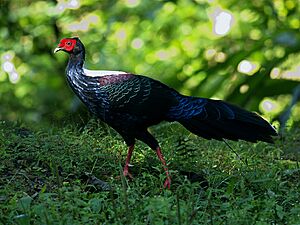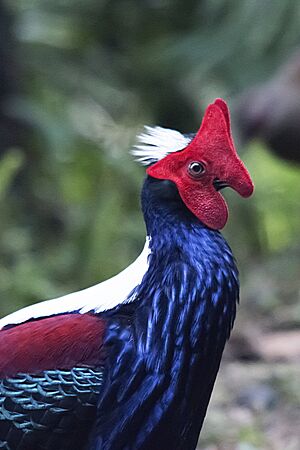Swinhoe's pheasant facts for kids
Quick facts for kids Swinhoe's pheasant |
|
|---|---|
 |
|
| Conservation status | |
| Scientific classification | |
| Genus: |
Lophura
|
| Species: |
swinhoii
|
| Synonyms | |
|
|
The Swinhoe's pheasant (Lophura swinhoii) is a beautiful bird found only in Taiwan. It's also called the Taiwan blue pheasant. This bird belongs to the pheasant family. Many people in Taiwan see it as a special symbol, like an unofficial national bird. This is because its colors – red, white, and blue – are similar to the Taiwanese flag. It shares this special status with the Mikado pheasant and the Taiwan blue magpie, which are also unique to Taiwan.
Contents
How the Swinhoe's Pheasant Got Its Name
This amazing bird was named after a British scientist, Robert Swinhoe. He was the first person to describe this species in 1862. In Mandarin Chinese, people call it lánfùxián, which means "blue-breasted kalij". In Taiwanese Hokkien, it's known as wa-koe, meaning "flowered fowl".
What Does a Swinhoe's Pheasant Look Like?
The male Swinhoe's pheasant is very colorful. He can grow up to 79 centimeters (about 31 inches) long. His chest, belly, and back are a shiny blue-purple. He has a white patch on his neck and a white crest of feathers on his head. Bright red skin, called wattles, hangs around his eyes. His tail feathers are white.
The female pheasant looks quite different. She is mostly brown with yellow, arrow-shaped spots. She also has interesting patterns on her feathers. Her outer tail feathers are a maroon color. Young male pheasants are dark blue with brown and yellow patterns on their wings. You can also tell Swinhoe's pheasants apart from Mikado pheasants because they have red legs.
Male Display Behavior
When a male Swinhoe's pheasant wants to attract a female, he performs a special dance. His red wattles become very bright and swollen. He might hop, then run in a circle around the female. Sometimes, he will fan out his tail feathers in a front-facing display. He also makes a whirring sound with his wings, like other pheasants in his group.
Where Swinhoe's Pheasants Live
Swinhoe's pheasants live in the mountains of central Taiwan. They prefer to live in old, natural forests with broadleaf trees. You can find them at high elevations, up to 2,300 meters (about 7,500 feet) above sea level.
Swinhoe's Pheasant Life and Habits
These pheasants eat a variety of foods. They enjoy seeds, fruits, and some insects. They also eat other small animal matter they find.
Predators of the Swinhoe's Pheasant
Several animals hunt Swinhoe's pheasants. These include large birds like the crested goshawk, white-bellied sea eagle, Gurney's eagle, and spot-bellied eagle-owl. Mammals like the civet and badger also prey on them.
Reproduction and Young
A female Swinhoe's pheasant usually lays between two and six eggs. She sits on the eggs to keep them warm for 25 to 28 days. Once the chicks hatch, they grow very quickly. They can leave the nest when they are only 2 to 3 days old. Male pheasants are often seen with several females. This suggests they might have more than one mate, but scientists are still studying this behavior.
Protecting the Swinhoe's Pheasant
The Swinhoe's pheasant has a small population. They only live in a limited area, and their home is getting smaller. This is mainly because their forest habitat is being damaged. Logging, which is cutting down trees, has been a big problem. In the past, people also hunted these birds, causing some groups to disappear in the 1960s and 1970s.
Today, there are estimated to be over 10,000 Swinhoe's pheasants in the world. Some groups of these birds are safe inside protected areas. However, other groups might still be decreasing in number. Because they are seen as unofficial national symbols of Taiwan, along with the Mikado pheasant and Taiwan magpie, it has helped people care more about their protection.
In some places, like Dasyueshan National Forest Recreation Area, you can often see them feeding near roads. These spots have become popular for bird watchers. Sometimes, people who take photos of birds feed the pheasants. This practice is not allowed by park officials and can lead to a fine. Some conservationists also worry that feeding wild animals can harm them.
See also
- List of protected species in Taiwan
- List of endemic species of Taiwan
- List of endemic birds of Taiwan






